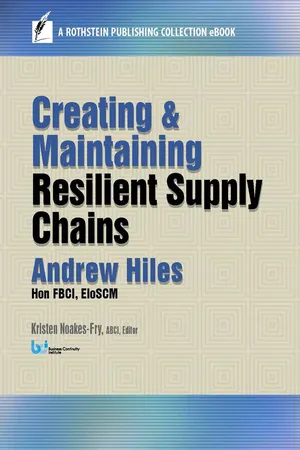
- 120 pages
- English
- ePUB (mobile friendly)
- Available on iOS & Android
Creating and Maintaining Resilient Supply Chains
About This Book
Creating and Maintaining Resilient Supply Chains
Will your supply chain survive the twists and turns of the global economy? Can it deliver mission-critical supplies and services in the face of disaster or other business interruption? A resilient supply chain can do those things and more. In Creating and Maintaining Resilient Supply Chains, global expert Andrew Hiles applies the principles of risk and business continuity to enable a reliable flow of materials and information that is a "win" for everyone involved.
From over 30 years of experience working with companies like yours, the author of Creating and Maintaining Resilient Supply Chains helps you to:
- Understand the criticality of procurement and supply chain management to the health of your organization.
- Relate the time-tested principles of good business continuity planning to constructing a reliable supply chain.
- Apply risk management principles to evaluate vendors and create effective contracts.
- Create the specifications that will result in a good tender or bid.
- Anticipate contract issues when you are dealing with other legal systems, including International Commercial Law, Anglo Saxon Law, Civil Code, Sharia Code, and European Law.
In one short book, Hiles distills the knowledge of a lifetime to prepare you to handle risks, pitfalls, and potential ambiguities. As a result, you will know how to carefully plan and negotiate supply chain relationships that benefit all the organizations involved.
Frequently asked questions
Information

Part 1
While many BCPs deal with physical incidents, you may face situations in which all your physical assets remain intact – and yet you still lose your operational capability. Perhaps the most common cause of these incidents is supply chain failure.
BC Managers need to work together with their colleagues in procurement departments to ensure continuity of mission-critical supplies and services. Even when supply is maintained, price shocks could impact an organization’s competitiveness severely – or even its viability.
- Relate your role as a BCM to supply chain continuity.
- Appreciate the criticality of procurement and supply chain management to your organization.
- Understand the basics of procurement including the procurement cycle and associated procedures.
- See how the supply chain works.
- Know the importance of strategic procurement.
- Identify key risks – and some solutions – in procurement, supply chain, and contract management.
1.1 Supply Chain Dependency
Sir Nick Scheele, of Ford, said, “Purchasing controls the ultimate profitability of the company.”1 In the public sector, this translates as, “Purchasing controls the volume and quality of service an entity can provide to its customers for a given budget.”
- Environmental. These include natural disasters (e.g., earthquakes, volcanic eruptions, tsunamis, extreme weather) and pandemics that disrupt production or delivery of product.
- Geopolitical. Civil disobedience, war, labor disputes, tariff hikes, sanctions, trade barriers, and customs difficulties come into this category.
- Economic. Sudden demand, loss of production by suppliers, or vendor bankruptcy may lead to price volatility or shortages.
- Technological. This includes transport failure and operational failure including failure of ICT systems, manufacturing, or mining equipment. Receipt of counterfeit or sub-standard product can also be included here. Premature obsolescence can also destroy viability.
- Bad weather was the main cause of disruption around the world, with 53% citing it – up from 29% in 2011.
- Unplanned IT and telecommunication outages constituted the second most likely disruption, and the failure of service provision by outsourcers was third – up to 35% from 20% in 2009. These incidents led to a loss of productivity for over half of businesses.
- The average number of identified supply chain risks in the previous 12 months was 5, with some organizations reporting over 52.
- 20% admitted they had suffered damage to their brand or reputation as a result of supply chain disruptions.
- 50% have tried to optimize their businesses through outsourcing, consolidating suppliers, just in time (JIT), or lean manufacturing techniques.
- Where businesses have shifted production to low-cost countries, they are significantly more likely to experience supply chain disruptions, with 83% experiencing disruption. The main causes were transport networks and supplier insolvency.
- Only 7% had been fully successful in ensuring that suppliers adopted BCM practices to meet their needs, with nearly a quarter not taking this step. Even when suppliers were regarded as key to their business, nearly half of respondents had not checked or validated their suppliers’ BC plans.
Table of contents
- Cover
- Title Page
- Copyright Page
- Introduction
- Part 1
- Footnotes 1
- Part 2
- Footnotes 2
- Appendix A
- About the Author